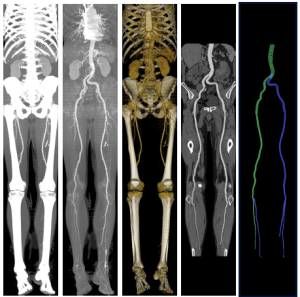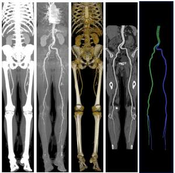Information
- Publication Type: PhD-Thesis
- Workgroup(s)/Project(s): not specified
- Date: August 2006
- Date (Start): April 2002
- Date (End): August 2006
- Second Supervisor: Eduard Gröller
- Rigorosum: 27. August 2006
- First Supervisor: Milos Sramek
- Keywords: Visualization, Medial Data Processing, Segmentation, Vessel Modeling, 3D Reconstruction, Vessel Visualization
Abstract
In this thesis, individual steps of a pipeline for processing of the peripheral Computed Tomography Angiography (CTA) datasets are addressed. The peripheral CTA datasets are volumetric datasets representing pathologies in vascularity of the lower extremities in the human body. These pathologies result from various atherosclerotic diseases as e.g. the Peripheral Arterial Occlusive Disease (PAOD) and their early and precise diagnostics significantly contributes to planning of a later interventional radiology treatment.The diagnostics is based on visualization of the imaged vascular tree, where individual pathologic changes, as plaque, calcifications, stenoses of the vessel lumen and occluded parts of the vessels are visible. CTA has evolved within the recent years into a robust, accurate and cost effective imaging technique for patients with both coronary and arterial diseases. As a result of the CTA scanning, a set of 1200–2000 transverse slices is acquired, depicting vessels enhanced by means of an intravenously injected contrast medium. The number of slices is high and therefore their manual examination is laborious and lengthy. As a remedy, post-processing methods were developed to allow faster and more intuitive visualization of the imaged vascularity. However, simple visualization by means of the traditional techniques as maximum-intensity projection (MIP) or direct volume rendering (DVR) is hampered due to the presence of bones in the dataset, which occlude the vessels. Therefore, a sequence of operations—the processing pipeline—is needed, leading to generation of clinically relevant images which depict unobstructed vessels.
In the first step of the pipeline the dataset is segmented and the tissues are classified, to allow subsequent vessel identification and bone removal. This is a complex task because of high density and spatial variability of the tissues. Traditional image processing techniques do not deliver acceptable results and therefore in the thesis we present new approaches that introduce additional ’anatomic’ information into the segmentation and classification process. We propose a probabilistic atlas which enables modeling of spatial and density distributions of vessel and bone tissues in datasets, to allow their improved classification. In the atlas construction the non-rigid thin-plate spline warping and registration of the datasets are applied, to address the high anatomic variability among the patients. The concept of the atlas is further extended by means of the watershed transform, to further improve precision of the registration procedure. Alternatively, we propose and evaluate a technique for vessel enhancement based on Hessian filtering to allow detection and recognition of vessel structures without operator supervision.
In the second step a geometric model of the vessel tree is constructed to derive information about the vessel centerlines. Here, an already available algorithm based on the so-called vessel-tracking, implemented by means of optimal path searching, is exploited with improvements to make the geometric model more precise.
The third step of the processing pipeline—visualization—requires this model, since its results can be significantly influenced by a potential imperfections, bringing in clinically misleading images. To address limitations of the vessel visualization by means of the existing techniques as MIP, CPR or DVR we propose their generalization in form of a focus & context-based concept called VesselGlyph. VesselGlyph enables to combine intuitively and systematically various visualization techniques to single a image to allow better, more comprehensive and unoccluded view of vessels for the diagnostic purposes.
To support the design and development of the proposed segmentation, modeling and visualization algorithms and to enable their application in the clinical environment, we implemented a set of tools grouped in the AngioVis ToolBox software. Within this application, individual steps of the processing pipeline are accomplished. The toolbox is complemented with additional utilities constituting together a fully-functional medical workstation software which is regularly used to process patient data on a daily basis in the clinical environment.
Additional Files and Images
Weblinks
No further information available.BibTeX
@phdthesis{straka-phd-thesis,
title = "Processing and Visualization of Peripheral CT-Angiography
Datasets",
author = "Mat\'{u}s Straka",
year = "2006",
abstract = "In this thesis, individual steps of a pipeline for
processing of the peripheral Computed Tomography Angiography
(CTA) datasets are addressed. The peripheral CTA datasets
are volumetric datasets representing pathologies in
vascularity of the lower extremities in the human body.
These pathologies result from various atherosclerotic
diseases as e.g. the Peripheral Arterial Occlusive Disease
(PAOD) and their early and precise diagnostics significantly
contributes to planning of a later interventional radiology
treatment. The diagnostics is based on visualization of the
imaged vascular tree, where individual pathologic changes,
as plaque, calcifications, stenoses of the vessel lumen and
occluded parts of the vessels are visible. CTA has evolved
within the recent years into a robust, accurate and cost
effective imaging technique for patients with both coronary
and arterial diseases. As a result of the CTA scanning, a
set of 1200–2000 transverse slices is acquired, depicting
vessels enhanced by means of an intravenously injected
contrast medium. The number of slices is high and therefore
their manual examination is laborious and lengthy. As a
remedy, post-processing methods were developed to allow
faster and more intuitive visualization of the imaged
vascularity. However, simple visualization by means of the
traditional techniques as maximum-intensity projection (MIP)
or direct volume rendering (DVR) is hampered due to the
presence of bones in the dataset, which occlude the vessels.
Therefore, a sequence of operations—the processing
pipeline—is needed, leading to generation of clinically
relevant images which depict unobstructed vessels. In the
first step of the pipeline the dataset is segmented and the
tissues are classified, to allow subsequent vessel
identification and bone removal. This is a complex task
because of high density and spatial variability of the
tissues. Traditional image processing techniques do not
deliver acceptable results and therefore in the thesis we
present new approaches that introduce additional
’anatomic’ information into the segmentation and
classification process. We propose a probabilistic atlas
which enables modeling of spatial and density distributions
of vessel and bone tissues in datasets, to allow their
improved classification. In the atlas construction the
non-rigid thin-plate spline warping and registration of the
datasets are applied, to address the high anatomic
variability among the patients. The concept of the atlas is
further extended by means of the watershed transform, to
further improve precision of the registration procedure.
Alternatively, we propose and evaluate a technique for
vessel enhancement based on Hessian filtering to allow
detection and recognition of vessel structures without
operator supervision. In the second step a geometric model
of the vessel tree is constructed to derive information
about the vessel centerlines. Here, an already available
algorithm based on the so-called vessel-tracking,
implemented by means of optimal path searching, is exploited
with improvements to make the geometric model more precise.
The third step of the processing
pipeline—visualization—requires this model, since its
results can be significantly influenced by a potential
imperfections, bringing in clinically misleading images. To
address limitations of the vessel visualization by means of
the existing techniques as MIP, CPR or DVR we propose their
generalization in form of a focus & context-based concept
called VesselGlyph. VesselGlyph enables to combine
intuitively and systematically various visualization
techniques to single a image to allow better, more
comprehensive and unoccluded view of vessels for the
diagnostic purposes. To support the design and development
of the proposed segmentation, modeling and visualization
algorithms and to enable their application in the clinical
environment, we implemented a set of tools grouped in the
AngioVis ToolBox software. Within this application,
individual steps of the processing pipeline are
accomplished. The toolbox is complemented with additional
utilities constituting together a fully-functional medical
workstation software which is regularly used to process
patient data on a daily basis in the clinical environment.",
month = aug,
address = "Favoritenstrasse 9-11/E193-02, A-1040 Vienna, Austria",
school = "Institute of Computer Graphics and Algorithms, Vienna
University of Technology ",
keywords = "Visualization, Medial Data Processing, Segmentation, Vessel
Modeling, 3D Reconstruction, Vessel Visualization",
URL = "https://www.cg.tuwien.ac.at/research/publications/2006/straka-phd-thesis/",
}


 pdf
pdf

